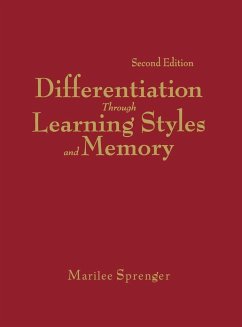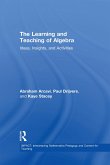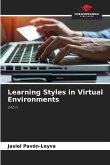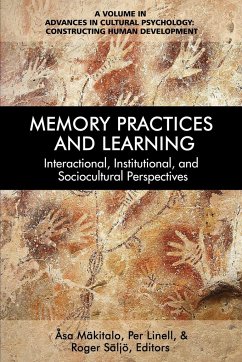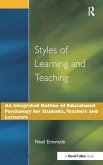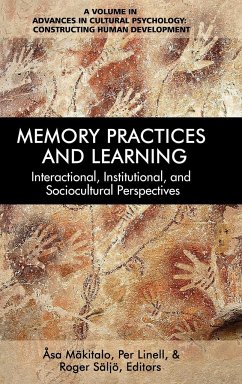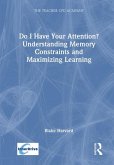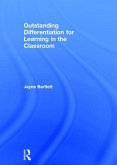Marilee Sprenger
Differentiation Through Learning Styles and Memory
Marilee Sprenger
Differentiation Through Learning Styles and Memory
- Gebundenes Buch
- Merkliste
- Auf die Merkliste
- Bewerten Bewerten
- Teilen
- Produkt teilen
- Produkterinnerung
- Produkterinnerung
Help students lead with their strengths and gain a deeper understanding of concepts! This updated edition of the bestseller demonstrates how to optimize learning by using strategies that address students' social/emotional, cognitive, and physical learning needs. The second edition offers current research on memory, graphic organizers, and new charts to help implement differentiated strategies, and also covers: How the brain processes, stores, and retains information Pre-assessment strategies for each learning style "Reflect and Connect" questions to help teachers evaluate their current…mehr
Andere Kunden interessierten sich auch für
![The Learning and Teaching of Algebra The Learning and Teaching of Algebra]() Abraham ArcaviThe Learning and Teaching of Algebra173,99 €
Abraham ArcaviThe Learning and Teaching of Algebra173,99 €![Learning Styles in Virtual Environments Learning Styles in Virtual Environments]() Jasiel Pavón-LeyvaLearning Styles in Virtual Environments26,99 €
Jasiel Pavón-LeyvaLearning Styles in Virtual Environments26,99 €![Memory Practices and Learning Memory Practices and Learning]() Memory Practices and Learning70,99 €
Memory Practices and Learning70,99 €![Styles of Learning and Teaching Styles of Learning and Teaching]() Noel J EntwistleStyles of Learning and Teaching183,99 €
Noel J EntwistleStyles of Learning and Teaching183,99 €![Memory Practices and Learning Memory Practices and Learning]() Memory Practices and Learning115,99 €
Memory Practices and Learning115,99 €![Do I Have Your Attention? Understanding Memory Constraints and Maximizing Learning Do I Have Your Attention? Understanding Memory Constraints and Maximizing Learning]() Blake HarvardDo I Have Your Attention? Understanding Memory Constraints and Maximizing Learning164,99 €
Blake HarvardDo I Have Your Attention? Understanding Memory Constraints and Maximizing Learning164,99 €![Outstanding Differentiation for Learning in the Classroom Outstanding Differentiation for Learning in the Classroom]() Jayne BartlettOutstanding Differentiation for Learning in the Classroom164,99 €
Jayne BartlettOutstanding Differentiation for Learning in the Classroom164,99 €-
-
-
Help students lead with their strengths and gain a deeper understanding of concepts! This updated edition of the bestseller demonstrates how to optimize learning by using strategies that address students' social/emotional, cognitive, and physical learning needs. The second edition offers current research on memory, graphic organizers, and new charts to help implement differentiated strategies, and also covers: How the brain processes, stores, and retains information Pre-assessment strategies for each learning style "Reflect and Connect" questions to help teachers evaluate their current classroom practice Text boxes that highlight contents of each chapter Learning and memory tips for students
Produktdetails
- Produktdetails
- Verlag: Corwin
- 2. Auflage
- Seitenzahl: 186
- Erscheinungstermin: 25. April 2008
- Englisch
- Abmessung: 286mm x 221mm x 15mm
- Gewicht: 743g
- ISBN-13: 9781412955447
- ISBN-10: 1412955440
- Artikelnr.: 23516798
- Herstellerkennzeichnung
- Libri GmbH
- Europaallee 1
- 36244 Bad Hersfeld
- gpsr@libri.de
- Verlag: Corwin
- 2. Auflage
- Seitenzahl: 186
- Erscheinungstermin: 25. April 2008
- Englisch
- Abmessung: 286mm x 221mm x 15mm
- Gewicht: 743g
- ISBN-13: 9781412955447
- ISBN-10: 1412955440
- Artikelnr.: 23516798
- Herstellerkennzeichnung
- Libri GmbH
- Europaallee 1
- 36244 Bad Hersfeld
- gpsr@libri.de
Marilee Sprenger is an adjunct professor at Aurora University, where she teaches graduate courses on brain-based teaching, learning and memory, and differentiation. A creative and compassionate educator, she began her career teaching prekindergarten and kindergarten. She has also taught at the elementary, middle, and high school level. As an independent consultant, her passion is brain-based teaching and best practices using brain research and differentiation. She also consults in the areas of learning styles, using music in the classroom, teaming, multiple intelligences, emotional intelligence, and memory. As an educational consultant with Two Rivers Professional Development Center, she worked for the Illinois Regional Offices of Education in the area of staff development associated with learning standards and testing. She speaks internationally, and her interactive and engaging style allows participants to make connections with their classrooms and their students. She is affiliated with the American Academy of Neurology and is constantly updated on current research. Sprenger is the author of several books, including Memory 101 for Educators and Becoming a Wiz at Brain-Based Teaching, Second Edition, published by Corwin Press. She has contributed to textbooks, and her articles have appeared in publications such as Educational Leadership and the ASCD Brain-based Education/Learning Styles Networker. Her dedication to education has won her many awards, but she cherishes most the wonderful students and teachers whose lives have touched hers.
Acknowledgments About the Author Prologue The Way We Do the Things We Do 1. Environments for Learning Reflect and Connect What Is Differentiated Instruction? Maslow
s Hierarchy of Human Needs Physiological Needs Safety Needs Need to Belong Need for Esteem Need for Self-Actualization Classroom Environments Physical Environment An Attractive Environment Lighting Temperature Color Nutrition Music Humor Water Physical Safety Social/Emotional Environment Self-Awareness Self-Management Social Awareness Relationship Management Cognitive Environment Predictability Feedback Novelty Choice Challenge Reflection The Stage Is Set Different Strokes Exit Card 2. Getting to Know Your Students: Learning Strengths Reflect and Connect Different Learners/Different Teachers What Is a Learning Profile? Attention Patterns Why Sensory Pathways? Sensory Pathways Visual Auditory/Verbal Kinesthetic/Tactile Sensory Systems Visual Memory Preference Auditory/Verbal Memory Preference Kinesthetic/Tactile Memory Preferences Hands-On Learners Whole Body Learners Doodlers Perceptual Patterns The Need to Know Reteaching All Pathways Lead to Differentiation Different Strokes Exit Card 3. A Matter of Memory: Gaining a Better Understanding of How Students Remember Reflect and Connect Phases of Memory Categorizing Memory Sensory Memory Immediate Memory Active Working Memory Long-Term Memory Explicit Memory How Do We Deal With Explicit Information? Semantic Memory: Nothing but the Facts Episodic Memory: Making the Invisible Visible Implicit Memory Conditioned Response: Lasting Memories Procedural Memory: Just Do It! Emotional Memory: If They Can Feel It - They
ll Remember It! Using Memory Systems to Access Prior Knowledge Making Connections Differentiation Making Garpon Memorable Automatic Memory Emotional/Episodic Memory Everyone Should Be Familiar With Garpon: Is That Your Final Answer? Different Strokes Exit Card 4. Differentiating Content, Process, and Product for the Visual Learner Reflect and Connect Do You Teach for Visual Memory? Preassessment and the Visual Learner Differentiation Design for Learners With Strong Visual Memory Differentiating for Visual Memory and the Semantic System Differentiating for Visual Memory and the Episodic System Differentiating for Visual Memory and the Procedural System Differentiating for Visual Memory and Conditioned Response Differentiating for Visual Memory and the Emotional System Visual Memory: I
ll Show You What I Know! Bloom
s Taxonomy and the Visual Learner Knowledge Comprehension Application Analysis Synthesis Evaluation A Note About Synthesis Different Strokes Exit Card Visual Learner Snapshot 5. Differentiating Content, Process, and Product for the Auditory Learner Reflect and Connect Do You Teach for Auditory Memory? Preassessment and the Auditory Learner Differentiation Design for Learners With Strong Auditory Memory Differentiating for Auditory Memory and the Semantic System Differentiating for Auditory Memory and the Episodic System Differentiating for Auditory Memory and the Procedural System Differentiating for Auditory Memory and Conditioned Response Differentiating for Auditory Memory and the Emotional System Concentration and the Auditory Learner Auditory Memory: I
ll Tell It Like It Is! Bloom
s Taxonomy and the Auditory Learner Knowledge Comprehension Application Analysis Synthesis Evaluation Different Strokes Exit Card Auditory Learner Snapshot 6. Differentiating Content, Process, and Product for the Kinesthetic Learner Reflect and Connect Do You Teach for Kinesthetic Memory? Preassessment and the Kinesthetic Learner Differentiation Design for Learners With Strong Kinesthetic Memory Sameness Is Not Always Fairness Differentiating for Kinesthetic Memory and the Semantic System Differentiating for Kinesthetic Memory and the Episodic System Differentiating for Kinesthetic Memory and the Procedural System Differentiating for Kinesthetic Memory and Conditioned Response Differentiating for Kinesthetic Memory and the Emotional System Does It Really Make Any Difference? Kinesthetic Memory: I
d Rather Do It Myself! Bloom
s Taxonomy and the Kinesthetic Learner Knowledge Comprehension Application Analysis Synthesis Evaluation The Critter Connection Different Strokes Exit Card Kinesthetic Learner Snapshot 7. Putting It All Together: Memory C.R.E.E.P.S. In! Reflect and Connect Identifying Learning Strengths A Closer Look Jeffrey Elise Jordan Isaac Micayla Tobias Lemar Amos Amanda Calvin An Eye Cue Visual Auditory Kinesthetic Remembering to Remember Thinking About Thinking Differentiated Instructional Strategies That Work for All Learners Cubing Jigsaw Different Strokes Exit Card Learning and Memory Tips for Students Epilogue Bibliography Index
s Hierarchy of Human Needs Physiological Needs Safety Needs Need to Belong Need for Esteem Need for Self-Actualization Classroom Environments Physical Environment An Attractive Environment Lighting Temperature Color Nutrition Music Humor Water Physical Safety Social/Emotional Environment Self-Awareness Self-Management Social Awareness Relationship Management Cognitive Environment Predictability Feedback Novelty Choice Challenge Reflection The Stage Is Set Different Strokes Exit Card 2. Getting to Know Your Students: Learning Strengths Reflect and Connect Different Learners/Different Teachers What Is a Learning Profile? Attention Patterns Why Sensory Pathways? Sensory Pathways Visual Auditory/Verbal Kinesthetic/Tactile Sensory Systems Visual Memory Preference Auditory/Verbal Memory Preference Kinesthetic/Tactile Memory Preferences Hands-On Learners Whole Body Learners Doodlers Perceptual Patterns The Need to Know Reteaching All Pathways Lead to Differentiation Different Strokes Exit Card 3. A Matter of Memory: Gaining a Better Understanding of How Students Remember Reflect and Connect Phases of Memory Categorizing Memory Sensory Memory Immediate Memory Active Working Memory Long-Term Memory Explicit Memory How Do We Deal With Explicit Information? Semantic Memory: Nothing but the Facts Episodic Memory: Making the Invisible Visible Implicit Memory Conditioned Response: Lasting Memories Procedural Memory: Just Do It! Emotional Memory: If They Can Feel It - They
ll Remember It! Using Memory Systems to Access Prior Knowledge Making Connections Differentiation Making Garpon Memorable Automatic Memory Emotional/Episodic Memory Everyone Should Be Familiar With Garpon: Is That Your Final Answer? Different Strokes Exit Card 4. Differentiating Content, Process, and Product for the Visual Learner Reflect and Connect Do You Teach for Visual Memory? Preassessment and the Visual Learner Differentiation Design for Learners With Strong Visual Memory Differentiating for Visual Memory and the Semantic System Differentiating for Visual Memory and the Episodic System Differentiating for Visual Memory and the Procedural System Differentiating for Visual Memory and Conditioned Response Differentiating for Visual Memory and the Emotional System Visual Memory: I
ll Show You What I Know! Bloom
s Taxonomy and the Visual Learner Knowledge Comprehension Application Analysis Synthesis Evaluation A Note About Synthesis Different Strokes Exit Card Visual Learner Snapshot 5. Differentiating Content, Process, and Product for the Auditory Learner Reflect and Connect Do You Teach for Auditory Memory? Preassessment and the Auditory Learner Differentiation Design for Learners With Strong Auditory Memory Differentiating for Auditory Memory and the Semantic System Differentiating for Auditory Memory and the Episodic System Differentiating for Auditory Memory and the Procedural System Differentiating for Auditory Memory and Conditioned Response Differentiating for Auditory Memory and the Emotional System Concentration and the Auditory Learner Auditory Memory: I
ll Tell It Like It Is! Bloom
s Taxonomy and the Auditory Learner Knowledge Comprehension Application Analysis Synthesis Evaluation Different Strokes Exit Card Auditory Learner Snapshot 6. Differentiating Content, Process, and Product for the Kinesthetic Learner Reflect and Connect Do You Teach for Kinesthetic Memory? Preassessment and the Kinesthetic Learner Differentiation Design for Learners With Strong Kinesthetic Memory Sameness Is Not Always Fairness Differentiating for Kinesthetic Memory and the Semantic System Differentiating for Kinesthetic Memory and the Episodic System Differentiating for Kinesthetic Memory and the Procedural System Differentiating for Kinesthetic Memory and Conditioned Response Differentiating for Kinesthetic Memory and the Emotional System Does It Really Make Any Difference? Kinesthetic Memory: I
d Rather Do It Myself! Bloom
s Taxonomy and the Kinesthetic Learner Knowledge Comprehension Application Analysis Synthesis Evaluation The Critter Connection Different Strokes Exit Card Kinesthetic Learner Snapshot 7. Putting It All Together: Memory C.R.E.E.P.S. In! Reflect and Connect Identifying Learning Strengths A Closer Look Jeffrey Elise Jordan Isaac Micayla Tobias Lemar Amos Amanda Calvin An Eye Cue Visual Auditory Kinesthetic Remembering to Remember Thinking About Thinking Differentiated Instructional Strategies That Work for All Learners Cubing Jigsaw Different Strokes Exit Card Learning and Memory Tips for Students Epilogue Bibliography Index
Acknowledgments About the Author Prologue The Way We Do the Things We Do 1. Environments for Learning Reflect and Connect What Is Differentiated Instruction? Maslow
s Hierarchy of Human Needs Physiological Needs Safety Needs Need to Belong Need for Esteem Need for Self-Actualization Classroom Environments Physical Environment An Attractive Environment Lighting Temperature Color Nutrition Music Humor Water Physical Safety Social/Emotional Environment Self-Awareness Self-Management Social Awareness Relationship Management Cognitive Environment Predictability Feedback Novelty Choice Challenge Reflection The Stage Is Set Different Strokes Exit Card 2. Getting to Know Your Students: Learning Strengths Reflect and Connect Different Learners/Different Teachers What Is a Learning Profile? Attention Patterns Why Sensory Pathways? Sensory Pathways Visual Auditory/Verbal Kinesthetic/Tactile Sensory Systems Visual Memory Preference Auditory/Verbal Memory Preference Kinesthetic/Tactile Memory Preferences Hands-On Learners Whole Body Learners Doodlers Perceptual Patterns The Need to Know Reteaching All Pathways Lead to Differentiation Different Strokes Exit Card 3. A Matter of Memory: Gaining a Better Understanding of How Students Remember Reflect and Connect Phases of Memory Categorizing Memory Sensory Memory Immediate Memory Active Working Memory Long-Term Memory Explicit Memory How Do We Deal With Explicit Information? Semantic Memory: Nothing but the Facts Episodic Memory: Making the Invisible Visible Implicit Memory Conditioned Response: Lasting Memories Procedural Memory: Just Do It! Emotional Memory: If They Can Feel It - They
ll Remember It! Using Memory Systems to Access Prior Knowledge Making Connections Differentiation Making Garpon Memorable Automatic Memory Emotional/Episodic Memory Everyone Should Be Familiar With Garpon: Is That Your Final Answer? Different Strokes Exit Card 4. Differentiating Content, Process, and Product for the Visual Learner Reflect and Connect Do You Teach for Visual Memory? Preassessment and the Visual Learner Differentiation Design for Learners With Strong Visual Memory Differentiating for Visual Memory and the Semantic System Differentiating for Visual Memory and the Episodic System Differentiating for Visual Memory and the Procedural System Differentiating for Visual Memory and Conditioned Response Differentiating for Visual Memory and the Emotional System Visual Memory: I
ll Show You What I Know! Bloom
s Taxonomy and the Visual Learner Knowledge Comprehension Application Analysis Synthesis Evaluation A Note About Synthesis Different Strokes Exit Card Visual Learner Snapshot 5. Differentiating Content, Process, and Product for the Auditory Learner Reflect and Connect Do You Teach for Auditory Memory? Preassessment and the Auditory Learner Differentiation Design for Learners With Strong Auditory Memory Differentiating for Auditory Memory and the Semantic System Differentiating for Auditory Memory and the Episodic System Differentiating for Auditory Memory and the Procedural System Differentiating for Auditory Memory and Conditioned Response Differentiating for Auditory Memory and the Emotional System Concentration and the Auditory Learner Auditory Memory: I
ll Tell It Like It Is! Bloom
s Taxonomy and the Auditory Learner Knowledge Comprehension Application Analysis Synthesis Evaluation Different Strokes Exit Card Auditory Learner Snapshot 6. Differentiating Content, Process, and Product for the Kinesthetic Learner Reflect and Connect Do You Teach for Kinesthetic Memory? Preassessment and the Kinesthetic Learner Differentiation Design for Learners With Strong Kinesthetic Memory Sameness Is Not Always Fairness Differentiating for Kinesthetic Memory and the Semantic System Differentiating for Kinesthetic Memory and the Episodic System Differentiating for Kinesthetic Memory and the Procedural System Differentiating for Kinesthetic Memory and Conditioned Response Differentiating for Kinesthetic Memory and the Emotional System Does It Really Make Any Difference? Kinesthetic Memory: I
d Rather Do It Myself! Bloom
s Taxonomy and the Kinesthetic Learner Knowledge Comprehension Application Analysis Synthesis Evaluation The Critter Connection Different Strokes Exit Card Kinesthetic Learner Snapshot 7. Putting It All Together: Memory C.R.E.E.P.S. In! Reflect and Connect Identifying Learning Strengths A Closer Look Jeffrey Elise Jordan Isaac Micayla Tobias Lemar Amos Amanda Calvin An Eye Cue Visual Auditory Kinesthetic Remembering to Remember Thinking About Thinking Differentiated Instructional Strategies That Work for All Learners Cubing Jigsaw Different Strokes Exit Card Learning and Memory Tips for Students Epilogue Bibliography Index
s Hierarchy of Human Needs Physiological Needs Safety Needs Need to Belong Need for Esteem Need for Self-Actualization Classroom Environments Physical Environment An Attractive Environment Lighting Temperature Color Nutrition Music Humor Water Physical Safety Social/Emotional Environment Self-Awareness Self-Management Social Awareness Relationship Management Cognitive Environment Predictability Feedback Novelty Choice Challenge Reflection The Stage Is Set Different Strokes Exit Card 2. Getting to Know Your Students: Learning Strengths Reflect and Connect Different Learners/Different Teachers What Is a Learning Profile? Attention Patterns Why Sensory Pathways? Sensory Pathways Visual Auditory/Verbal Kinesthetic/Tactile Sensory Systems Visual Memory Preference Auditory/Verbal Memory Preference Kinesthetic/Tactile Memory Preferences Hands-On Learners Whole Body Learners Doodlers Perceptual Patterns The Need to Know Reteaching All Pathways Lead to Differentiation Different Strokes Exit Card 3. A Matter of Memory: Gaining a Better Understanding of How Students Remember Reflect and Connect Phases of Memory Categorizing Memory Sensory Memory Immediate Memory Active Working Memory Long-Term Memory Explicit Memory How Do We Deal With Explicit Information? Semantic Memory: Nothing but the Facts Episodic Memory: Making the Invisible Visible Implicit Memory Conditioned Response: Lasting Memories Procedural Memory: Just Do It! Emotional Memory: If They Can Feel It - They
ll Remember It! Using Memory Systems to Access Prior Knowledge Making Connections Differentiation Making Garpon Memorable Automatic Memory Emotional/Episodic Memory Everyone Should Be Familiar With Garpon: Is That Your Final Answer? Different Strokes Exit Card 4. Differentiating Content, Process, and Product for the Visual Learner Reflect and Connect Do You Teach for Visual Memory? Preassessment and the Visual Learner Differentiation Design for Learners With Strong Visual Memory Differentiating for Visual Memory and the Semantic System Differentiating for Visual Memory and the Episodic System Differentiating for Visual Memory and the Procedural System Differentiating for Visual Memory and Conditioned Response Differentiating for Visual Memory and the Emotional System Visual Memory: I
ll Show You What I Know! Bloom
s Taxonomy and the Visual Learner Knowledge Comprehension Application Analysis Synthesis Evaluation A Note About Synthesis Different Strokes Exit Card Visual Learner Snapshot 5. Differentiating Content, Process, and Product for the Auditory Learner Reflect and Connect Do You Teach for Auditory Memory? Preassessment and the Auditory Learner Differentiation Design for Learners With Strong Auditory Memory Differentiating for Auditory Memory and the Semantic System Differentiating for Auditory Memory and the Episodic System Differentiating for Auditory Memory and the Procedural System Differentiating for Auditory Memory and Conditioned Response Differentiating for Auditory Memory and the Emotional System Concentration and the Auditory Learner Auditory Memory: I
ll Tell It Like It Is! Bloom
s Taxonomy and the Auditory Learner Knowledge Comprehension Application Analysis Synthesis Evaluation Different Strokes Exit Card Auditory Learner Snapshot 6. Differentiating Content, Process, and Product for the Kinesthetic Learner Reflect and Connect Do You Teach for Kinesthetic Memory? Preassessment and the Kinesthetic Learner Differentiation Design for Learners With Strong Kinesthetic Memory Sameness Is Not Always Fairness Differentiating for Kinesthetic Memory and the Semantic System Differentiating for Kinesthetic Memory and the Episodic System Differentiating for Kinesthetic Memory and the Procedural System Differentiating for Kinesthetic Memory and Conditioned Response Differentiating for Kinesthetic Memory and the Emotional System Does It Really Make Any Difference? Kinesthetic Memory: I
d Rather Do It Myself! Bloom
s Taxonomy and the Kinesthetic Learner Knowledge Comprehension Application Analysis Synthesis Evaluation The Critter Connection Different Strokes Exit Card Kinesthetic Learner Snapshot 7. Putting It All Together: Memory C.R.E.E.P.S. In! Reflect and Connect Identifying Learning Strengths A Closer Look Jeffrey Elise Jordan Isaac Micayla Tobias Lemar Amos Amanda Calvin An Eye Cue Visual Auditory Kinesthetic Remembering to Remember Thinking About Thinking Differentiated Instructional Strategies That Work for All Learners Cubing Jigsaw Different Strokes Exit Card Learning and Memory Tips for Students Epilogue Bibliography Index

